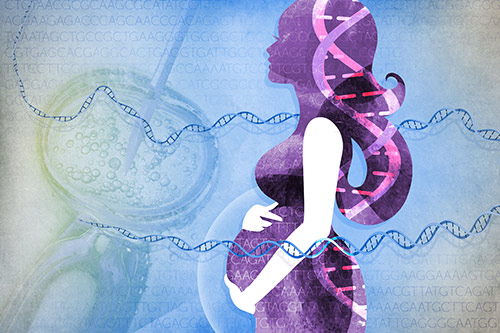
Screening a fetus for genetic abnormalities is not a new idea or technology, but a new single-cell prenatal blood test can make this experience an easier and safer procedure.
A new assay developed by Kenichiro Hata and colleagues in Japan has completed its first clinical experiment, and published a proof-of-concept study showing how DNA can be analyzed from numerous live cells from the blood of the mother during the pregnancy, via a single cell digital PCR assay. This new assay improves on current assay technology in that it is no longer necessary to use cell fixation, cell staining, or whole-genome amplification – each being timely and costly procedures. This new assay is also intended to solve another pre-existing limitation of established non-invasive prenatal tests (NIPTs), where after the test the results are non-informative. Risking the health of the fetus for a test that could be inconclusive is rather problematic, something Hata and colleagues hope to improve upon.
NIPTs have been used for fetal genetic disease screening in pregnant women for many years, and this test usually involves delicate procedures where genetic material is removed from the womb, such as amniocentesis. Tests such as these carry the risk of causing fetal harm, but they are necessary to test for the baby’s health, particularly if there are known risks (genetic or otherwise) with the pregnancy.
Hata has developed a single-cell DNA assessment method that maintains high sensitivity and specificity, while being a noninvasive test. Based off the fact there is a presence of fetal cells in maternal blood circulation, he has managed to create a system where live fetal cells and their genetic material can be directly extracted for evaluation straight from a simple blood sample of the mother. This methodology can also improves the likelihood of detecting a fetal anomaly.
Using a modified, single-cell-based droplet digital PCR (sc-ddPCR) NIPT, researchers conducted a proof of concept study that successfully assessed the genetic information of mutations in the fetal cells. It was not necessary to enter the womb or touch the fetus, and the genetic material that was isolated could be used immediately.
“Because NIPTs currently analyze small DNA fragments, it can be challenging to ascertain whether the origin of each DNA fragment is the mother or her fetus,” explained lead investigator Kenichiro Hata, M.D., Ph.D., chairman of Maternal-Fetal Biology at the National Research Institute for Child Health and Development, Tokyo, Japan. “We have observed that in some cases NIPT results are discordant with the fetal genetic information that has been reported. This study serves as a proof of concept for noninvasive prenatal diagnosis using circulating fetal cells without any strict cell purification.”
With this modified technique, up to 3,000 cells per well can be encapsulated in each droplet and simultaneously analyzed. The original sc-ddPCR system simultaneously assesses single-cell genetic information with high sensitivity and specificity. However, the original system is only useful for cell suspensions with a clear background (i.e., washed cell lines or clearly sorted cells with fluorescence-activated cell sorting). Researchers modified this sc-ddPCR system to improve the PCR environment in each droplet with higher sensitivity and specificity, which makes it possible to now assess single-cell genetic information from crudely purified nucleated cell samples with impurities.
To confirm the sensitivity of this modified sc-ddPCR system, investigators detected the genomic DNA of circulating male fetal cells in a crudely sorted cell suspension at the single-cell level derived from peripheral blood samples from mothers with male fetuses.
Investigators searched for the presence of the sex-determining region Y gene (SRY), which is responsible for the initiation of male sex determination. The analysis of 13 blood samples revealed that only circulating fetal cells from the three pregnant women carrying male fetuses tested positive for the SRY gene, unlike cells from the 10 pregnant women carrying female fetuses.
“In the future, by optimizing cell sorting and encapsulation, as well as generating a more effective PCR environment in each droplet, this modified sc-ddPCR system may be a breakthrough analysis method that can be applied to various research realms and possibly to clinical diagnostic testing,” commented Hata.
While this is only the first step in testing this technology, the results present a positive outlook. Hata has managed to optimize cell sorting and encapsulation, as well as generate a more effective PCR environment in each droplet, allowing this modified sc-ddPCR system to improve upon previous assays.
This breakthrough analysis methods can be applied to various research realms, and possibly to clinical diagnostic testing. To effectively and reliably sort for rare cells circulating throughout the body has many uses, particularly in oncology and testing for infections. If this technology can be further tested in a clinical trial, where instead of testing for the SRY chromosome this assay could test for rare genetic and chromosome abnormalities (compared to standard methods), it would become the preferred technology in this field.











